February 8, 2010 at 3:36 pm
[caption id="attachment_198" align="alignleft" width="275" caption="Snowy egret at Ding Darling National Wildlife Refuge"]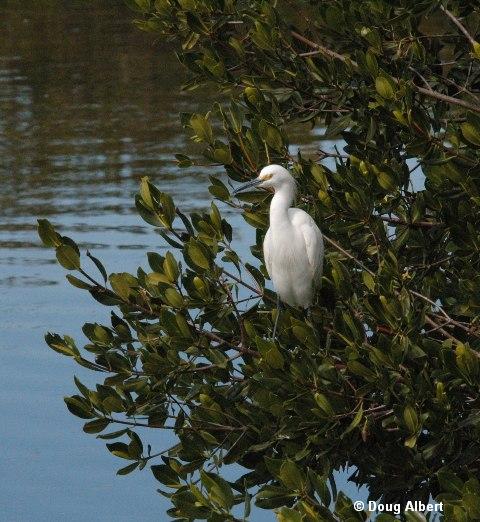 [/caption]
It’s now February, and winter has “set in” here in Maine for sure. Many of us forget that the now-frozen shorelines hosted feeding herons and egrets as recent as 3 months prior. Like many fair-weather Mainers, they choose to spend the winter in a place that’s a bit more hospitable…somewhere where the waters remain ice-free, somewhere warm, somewhere well south of here.
Two members of the Heron Observation Network monitor great blue heron colonies here in Maine during the spring and summer. But, their volunteer time in Florida during the winter also contributes quite considerably to the well-being of colonial wading birds. Below is their story, as told by Doug Albert:
Paula and I volunteer at two different wildlife agencies on Sanibel Island, Florida. In the winter months we work two days a week at the J.N. Ding Darling National Wildlife Refuge. We are also on-call 24/7 for wildlife rescue at the Clinic for the Rehabilitation of Wildlife (CROW).
[caption id="attachment_204" align="alignleft" width="300" caption="Lunchtime for wading birds at the Refuge."]
[/caption]
It’s now February, and winter has “set in” here in Maine for sure. Many of us forget that the now-frozen shorelines hosted feeding herons and egrets as recent as 3 months prior. Like many fair-weather Mainers, they choose to spend the winter in a place that’s a bit more hospitable…somewhere where the waters remain ice-free, somewhere warm, somewhere well south of here.
Two members of the Heron Observation Network monitor great blue heron colonies here in Maine during the spring and summer. But, their volunteer time in Florida during the winter also contributes quite considerably to the well-being of colonial wading birds. Below is their story, as told by Doug Albert:
Paula and I volunteer at two different wildlife agencies on Sanibel Island, Florida. In the winter months we work two days a week at the J.N. Ding Darling National Wildlife Refuge. We are also on-call 24/7 for wildlife rescue at the Clinic for the Rehabilitation of Wildlife (CROW).
[caption id="attachment_204" align="alignleft" width="300" caption="Lunchtime for wading birds at the Refuge."]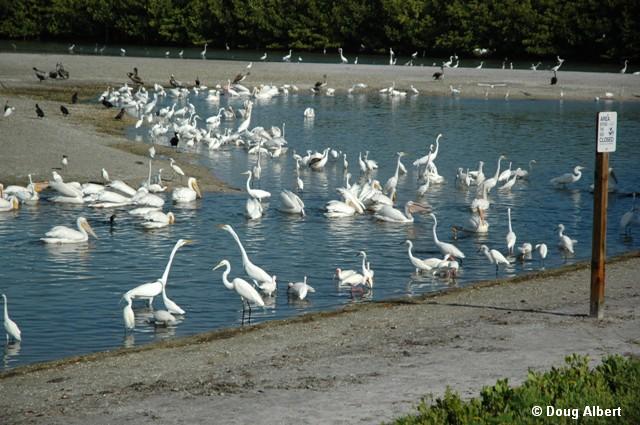 [/caption]
The ‘Ding’ Darling refuge contains 6,617 acres of wildlife habitat with over 220 species of birds. It provides an important stopover for the migrating birds using the Atlantic Flyway. We work as roving-educators on Wildlife Drive, a 4-mile lane open to the public for wildlife observation, biking, fishing and photography. During a 3-hour shift it is common to record 100 human visitors and over 35 different bird species; many are migratory snowbirds like us. We also help with monofilament removal on the refuge.
The refuge is well-known for its spectacular migratory bird population and the estuaries around Sanibel are world famous for fishing. Too often negative interactions take place between folks fishing and our birds, frequently to the detriment of the birds. Fishing lures and monofilament create major problems for bird populations. We know first hand: most of the birds we rescue for CROW involve injuries from monofilament, fish hooks or lures.
[caption id="attachment_208" align="alignleft" width="300" caption="Great blue heron that fell victim to fishing line."]
[/caption]
The ‘Ding’ Darling refuge contains 6,617 acres of wildlife habitat with over 220 species of birds. It provides an important stopover for the migrating birds using the Atlantic Flyway. We work as roving-educators on Wildlife Drive, a 4-mile lane open to the public for wildlife observation, biking, fishing and photography. During a 3-hour shift it is common to record 100 human visitors and over 35 different bird species; many are migratory snowbirds like us. We also help with monofilament removal on the refuge.
The refuge is well-known for its spectacular migratory bird population and the estuaries around Sanibel are world famous for fishing. Too often negative interactions take place between folks fishing and our birds, frequently to the detriment of the birds. Fishing lures and monofilament create major problems for bird populations. We know first hand: most of the birds we rescue for CROW involve injuries from monofilament, fish hooks or lures.
[caption id="attachment_208" align="alignleft" width="300" caption="Great blue heron that fell victim to fishing line."]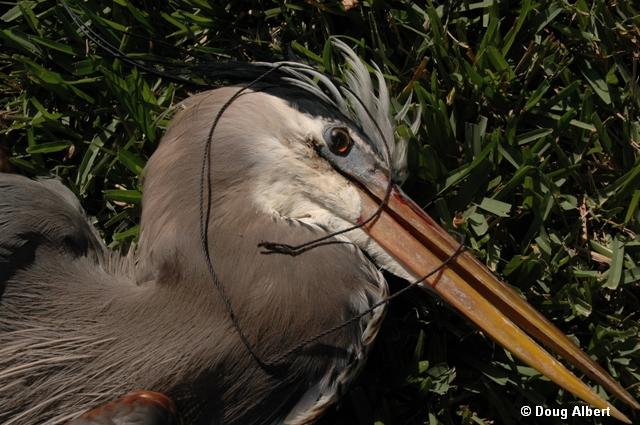 [/caption]
Established in 1968, CROW is one of the nation’s leading veterinarian hospitals specializing in tropical and migratory wildlife. Today the campus includes a new 4,800 square foot hospital, a student housing complex and the Healing Winds Visitor Center. CROW receives no federal or state funding, while serving the needs of over 4,000 wildlife patients annually. In 2009, 27 great blue herons were treated; cases similar to the bird we are currently attempting to help.
[caption id="attachment_209" align="alignleft" width="300" caption="Great blue heron with cotton line."]
[/caption]
Established in 1968, CROW is one of the nation’s leading veterinarian hospitals specializing in tropical and migratory wildlife. Today the campus includes a new 4,800 square foot hospital, a student housing complex and the Healing Winds Visitor Center. CROW receives no federal or state funding, while serving the needs of over 4,000 wildlife patients annually. In 2009, 27 great blue herons were treated; cases similar to the bird we are currently attempting to help.
[caption id="attachment_209" align="alignleft" width="300" caption="Great blue heron with cotton line."]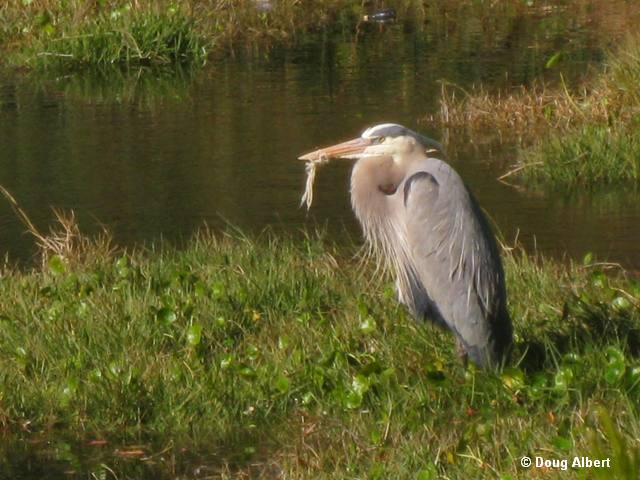 [/caption]
We recently received a call from CROW: there was a report of a large bird with line attached to its bill at a location in Fort Myers. Paula and I took the case, located the healthy and flighted great blue heron and confirmed that the bird’s bill was wrapped with cotton line. We decided to track and observe the heron, hoping it would be able to remove the line on its own. If not, we will find a suitable location where we can set up a mist-net to safely capture the bird, which will then be transported to CROW and handed over to the veterinarians for treatment and rehabilitation.
Now let me share a true rescue story with you…
[caption id="attachment_210" align="alignleft" width="300" caption="Snowy egret out on a limb."]
[/caption]
We recently received a call from CROW: there was a report of a large bird with line attached to its bill at a location in Fort Myers. Paula and I took the case, located the healthy and flighted great blue heron and confirmed that the bird’s bill was wrapped with cotton line. We decided to track and observe the heron, hoping it would be able to remove the line on its own. If not, we will find a suitable location where we can set up a mist-net to safely capture the bird, which will then be transported to CROW and handed over to the veterinarians for treatment and rehabilitation.
Now let me share a true rescue story with you…
[caption id="attachment_210" align="alignleft" width="300" caption="Snowy egret out on a limb."]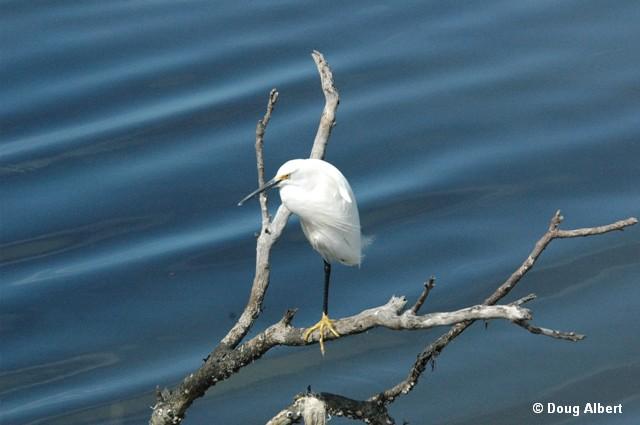 [/caption]
“Snowy egret with a broken wing reported at Alligator Curve,” was the call I received from Sue at CROW. They often call me when others fail; she said the refuge rangers were unable to capture the bird; a CROW staff member also tried but was unsuccessful.
Sue continued, “The poor bird has a broken wing. We’ve received so many calls; it’s been at that location for a week.” While I was listening I was wondering why the bird hadn’t been caught; Sue sensed my question. “Yes, Alligator Curve,” she responded, “you understand the rule about not going in the water, right?” I understood, alligators will attack anything that enters their territory especially if it happens to be a female with young. I agreed to give it a try; as I drove to the refuge I reflected on alligator behavior. A conversation with the ranger confirmed my suspicion: yes, there was a female gator with young at that location.
[caption id="attachment_211" align="alignleft" width="300" caption="Doug Albert with 2 helpers and a brown pelican they successfully rescued."]
[/caption]
“Snowy egret with a broken wing reported at Alligator Curve,” was the call I received from Sue at CROW. They often call me when others fail; she said the refuge rangers were unable to capture the bird; a CROW staff member also tried but was unsuccessful.
Sue continued, “The poor bird has a broken wing. We’ve received so many calls; it’s been at that location for a week.” While I was listening I was wondering why the bird hadn’t been caught; Sue sensed my question. “Yes, Alligator Curve,” she responded, “you understand the rule about not going in the water, right?” I understood, alligators will attack anything that enters their territory especially if it happens to be a female with young. I agreed to give it a try; as I drove to the refuge I reflected on alligator behavior. A conversation with the ranger confirmed my suspicion: yes, there was a female gator with young at that location.
[caption id="attachment_211" align="alignleft" width="300" caption="Doug Albert with 2 helpers and a brown pelican they successfully rescued."]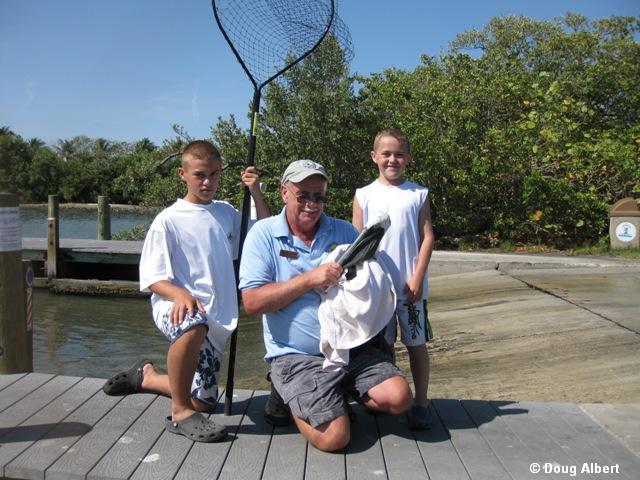 [/caption]
Alligator curve is located near the end of Wildlife Drive. Thick red mangroves on the water's edge made it difficult to find the egret, but finally I located the bird feeding on fish while hanging onto the aerial roots on the water's edge. With its damaged wing the egret could not fly away so I extended myself out onto the mangrove branches in an attempt to catch him by hand. Further and further I extended my weight over the water until I lunged for the bird. I heard the crack from the breaking limb and fell into the water. Suddenly I felt something hit my leg. Darn. Fortunately for me, it was the struggling egret; I grabbed him and headed for the safety of high ground.
Yes, I got my bird but that was dumb luck.
It is an honor to volunteer for a wonderful organization like CROW with dedicated staff providing care to our wildlife.
If you encounter an injured wild bird, please contact your local wildlife rehabilitator before attempting to rescue it.
[/caption]
Alligator curve is located near the end of Wildlife Drive. Thick red mangroves on the water's edge made it difficult to find the egret, but finally I located the bird feeding on fish while hanging onto the aerial roots on the water's edge. With its damaged wing the egret could not fly away so I extended myself out onto the mangrove branches in an attempt to catch him by hand. Further and further I extended my weight over the water until I lunged for the bird. I heard the crack from the breaking limb and fell into the water. Suddenly I felt something hit my leg. Darn. Fortunately for me, it was the struggling egret; I grabbed him and headed for the safety of high ground.
Yes, I got my bird but that was dumb luck.
It is an honor to volunteer for a wonderful organization like CROW with dedicated staff providing care to our wildlife.
If you encounter an injured wild bird, please contact your local wildlife rehabilitator before attempting to rescue it.
 [/caption]
It’s now February, and winter has “set in” here in Maine for sure. Many of us forget that the now-frozen shorelines hosted feeding herons and egrets as recent as 3 months prior. Like many fair-weather Mainers, they choose to spend the winter in a place that’s a bit more hospitable…somewhere where the waters remain ice-free, somewhere warm, somewhere well south of here.
Two members of the Heron Observation Network monitor great blue heron colonies here in Maine during the spring and summer. But, their volunteer time in Florida during the winter also contributes quite considerably to the well-being of colonial wading birds. Below is their story, as told by Doug Albert:
Paula and I volunteer at two different wildlife agencies on Sanibel Island, Florida. In the winter months we work two days a week at the J.N. Ding Darling National Wildlife Refuge. We are also on-call 24/7 for wildlife rescue at the Clinic for the Rehabilitation of Wildlife (CROW).
[caption id="attachment_204" align="alignleft" width="300" caption="Lunchtime for wading birds at the Refuge."]
[/caption]
It’s now February, and winter has “set in” here in Maine for sure. Many of us forget that the now-frozen shorelines hosted feeding herons and egrets as recent as 3 months prior. Like many fair-weather Mainers, they choose to spend the winter in a place that’s a bit more hospitable…somewhere where the waters remain ice-free, somewhere warm, somewhere well south of here.
Two members of the Heron Observation Network monitor great blue heron colonies here in Maine during the spring and summer. But, their volunteer time in Florida during the winter also contributes quite considerably to the well-being of colonial wading birds. Below is their story, as told by Doug Albert:
Paula and I volunteer at two different wildlife agencies on Sanibel Island, Florida. In the winter months we work two days a week at the J.N. Ding Darling National Wildlife Refuge. We are also on-call 24/7 for wildlife rescue at the Clinic for the Rehabilitation of Wildlife (CROW).
[caption id="attachment_204" align="alignleft" width="300" caption="Lunchtime for wading birds at the Refuge."] [/caption]
The ‘Ding’ Darling refuge contains 6,617 acres of wildlife habitat with over 220 species of birds. It provides an important stopover for the migrating birds using the Atlantic Flyway. We work as roving-educators on Wildlife Drive, a 4-mile lane open to the public for wildlife observation, biking, fishing and photography. During a 3-hour shift it is common to record 100 human visitors and over 35 different bird species; many are migratory snowbirds like us. We also help with monofilament removal on the refuge.
The refuge is well-known for its spectacular migratory bird population and the estuaries around Sanibel are world famous for fishing. Too often negative interactions take place between folks fishing and our birds, frequently to the detriment of the birds. Fishing lures and monofilament create major problems for bird populations. We know first hand: most of the birds we rescue for CROW involve injuries from monofilament, fish hooks or lures.
[caption id="attachment_208" align="alignleft" width="300" caption="Great blue heron that fell victim to fishing line."]
[/caption]
The ‘Ding’ Darling refuge contains 6,617 acres of wildlife habitat with over 220 species of birds. It provides an important stopover for the migrating birds using the Atlantic Flyway. We work as roving-educators on Wildlife Drive, a 4-mile lane open to the public for wildlife observation, biking, fishing and photography. During a 3-hour shift it is common to record 100 human visitors and over 35 different bird species; many are migratory snowbirds like us. We also help with monofilament removal on the refuge.
The refuge is well-known for its spectacular migratory bird population and the estuaries around Sanibel are world famous for fishing. Too often negative interactions take place between folks fishing and our birds, frequently to the detriment of the birds. Fishing lures and monofilament create major problems for bird populations. We know first hand: most of the birds we rescue for CROW involve injuries from monofilament, fish hooks or lures.
[caption id="attachment_208" align="alignleft" width="300" caption="Great blue heron that fell victim to fishing line."] [/caption]
Established in 1968, CROW is one of the nation’s leading veterinarian hospitals specializing in tropical and migratory wildlife. Today the campus includes a new 4,800 square foot hospital, a student housing complex and the Healing Winds Visitor Center. CROW receives no federal or state funding, while serving the needs of over 4,000 wildlife patients annually. In 2009, 27 great blue herons were treated; cases similar to the bird we are currently attempting to help.
[caption id="attachment_209" align="alignleft" width="300" caption="Great blue heron with cotton line."]
[/caption]
Established in 1968, CROW is one of the nation’s leading veterinarian hospitals specializing in tropical and migratory wildlife. Today the campus includes a new 4,800 square foot hospital, a student housing complex and the Healing Winds Visitor Center. CROW receives no federal or state funding, while serving the needs of over 4,000 wildlife patients annually. In 2009, 27 great blue herons were treated; cases similar to the bird we are currently attempting to help.
[caption id="attachment_209" align="alignleft" width="300" caption="Great blue heron with cotton line."] [/caption]
We recently received a call from CROW: there was a report of a large bird with line attached to its bill at a location in Fort Myers. Paula and I took the case, located the healthy and flighted great blue heron and confirmed that the bird’s bill was wrapped with cotton line. We decided to track and observe the heron, hoping it would be able to remove the line on its own. If not, we will find a suitable location where we can set up a mist-net to safely capture the bird, which will then be transported to CROW and handed over to the veterinarians for treatment and rehabilitation.
Now let me share a true rescue story with you…
[caption id="attachment_210" align="alignleft" width="300" caption="Snowy egret out on a limb."]
[/caption]
We recently received a call from CROW: there was a report of a large bird with line attached to its bill at a location in Fort Myers. Paula and I took the case, located the healthy and flighted great blue heron and confirmed that the bird’s bill was wrapped with cotton line. We decided to track and observe the heron, hoping it would be able to remove the line on its own. If not, we will find a suitable location where we can set up a mist-net to safely capture the bird, which will then be transported to CROW and handed over to the veterinarians for treatment and rehabilitation.
Now let me share a true rescue story with you…
[caption id="attachment_210" align="alignleft" width="300" caption="Snowy egret out on a limb."] [/caption]
“Snowy egret with a broken wing reported at Alligator Curve,” was the call I received from Sue at CROW. They often call me when others fail; she said the refuge rangers were unable to capture the bird; a CROW staff member also tried but was unsuccessful.
Sue continued, “The poor bird has a broken wing. We’ve received so many calls; it’s been at that location for a week.” While I was listening I was wondering why the bird hadn’t been caught; Sue sensed my question. “Yes, Alligator Curve,” she responded, “you understand the rule about not going in the water, right?” I understood, alligators will attack anything that enters their territory especially if it happens to be a female with young. I agreed to give it a try; as I drove to the refuge I reflected on alligator behavior. A conversation with the ranger confirmed my suspicion: yes, there was a female gator with young at that location.
[caption id="attachment_211" align="alignleft" width="300" caption="Doug Albert with 2 helpers and a brown pelican they successfully rescued."]
[/caption]
“Snowy egret with a broken wing reported at Alligator Curve,” was the call I received from Sue at CROW. They often call me when others fail; she said the refuge rangers were unable to capture the bird; a CROW staff member also tried but was unsuccessful.
Sue continued, “The poor bird has a broken wing. We’ve received so many calls; it’s been at that location for a week.” While I was listening I was wondering why the bird hadn’t been caught; Sue sensed my question. “Yes, Alligator Curve,” she responded, “you understand the rule about not going in the water, right?” I understood, alligators will attack anything that enters their territory especially if it happens to be a female with young. I agreed to give it a try; as I drove to the refuge I reflected on alligator behavior. A conversation with the ranger confirmed my suspicion: yes, there was a female gator with young at that location.
[caption id="attachment_211" align="alignleft" width="300" caption="Doug Albert with 2 helpers and a brown pelican they successfully rescued."] [/caption]
Alligator curve is located near the end of Wildlife Drive. Thick red mangroves on the water's edge made it difficult to find the egret, but finally I located the bird feeding on fish while hanging onto the aerial roots on the water's edge. With its damaged wing the egret could not fly away so I extended myself out onto the mangrove branches in an attempt to catch him by hand. Further and further I extended my weight over the water until I lunged for the bird. I heard the crack from the breaking limb and fell into the water. Suddenly I felt something hit my leg. Darn. Fortunately for me, it was the struggling egret; I grabbed him and headed for the safety of high ground.
Yes, I got my bird but that was dumb luck.
It is an honor to volunteer for a wonderful organization like CROW with dedicated staff providing care to our wildlife.
If you encounter an injured wild bird, please contact your local wildlife rehabilitator before attempting to rescue it.
[/caption]
Alligator curve is located near the end of Wildlife Drive. Thick red mangroves on the water's edge made it difficult to find the egret, but finally I located the bird feeding on fish while hanging onto the aerial roots on the water's edge. With its damaged wing the egret could not fly away so I extended myself out onto the mangrove branches in an attempt to catch him by hand. Further and further I extended my weight over the water until I lunged for the bird. I heard the crack from the breaking limb and fell into the water. Suddenly I felt something hit my leg. Darn. Fortunately for me, it was the struggling egret; I grabbed him and headed for the safety of high ground.
Yes, I got my bird but that was dumb luck.
It is an honor to volunteer for a wonderful organization like CROW with dedicated staff providing care to our wildlife.
If you encounter an injured wild bird, please contact your local wildlife rehabilitator before attempting to rescue it.
Categories